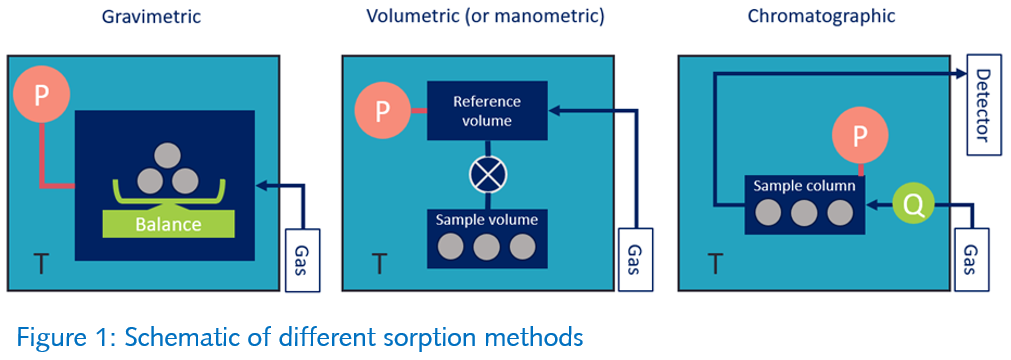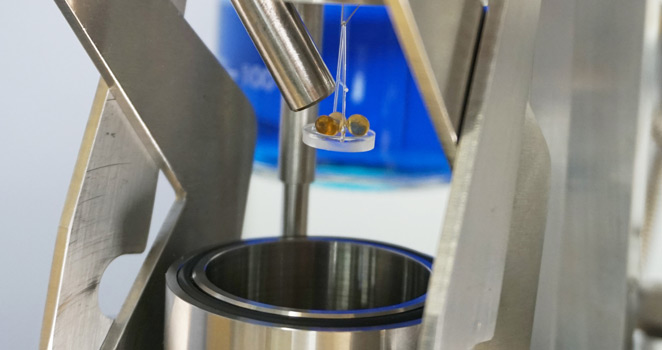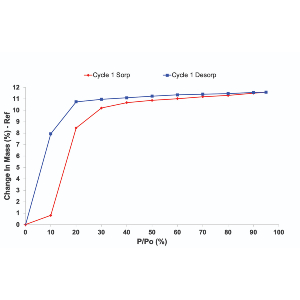
Expanded SLT Team
to usher in future of
Surface Measurement Systems
As Surface Measurement Systems Holding LLC and its subsidiaries enter an exciting new stage for the whole company, the Senior Leadership Team (SLT) has also had to expand to accomodate and realise the vision of the future.
Through the strategic elevation of existing staff and bringing on new team members, the SLT is better poised than ever to take Surface Measurement Systems to new heights, realising exciting new business opportunities, and continuing to improve and innovate our business offering.

Senior Leadership Team

Europe & US Symposiums bring leading sorption scientist together
2024 saw a grand return for the live editions of the Sorption Symposium Series. With the 202 Pandemic scuppering plans for a live scientific event in 2020, Surface Measurement Systems were thrilled to be able to bring the event back to the face-to-face format, enabling a shared learning and networking experience for sorption scientists from around the world.
Eager to offer an in-person return to our users and peers around the world, the Sorption Symposium saw two live events held this year. The first, taking place in May, was held at the New Jersey Institute of Technology, while the second returned to the venue we had to cancel in 2020, University of Vienna, for our European symposium in September.

Sorption Symposium North America 2024 (7 – 9 May)
Gathers Leading Sorption Experts in New Jersey
Gathers Leading Sorption Experts in New Jersey
| The Sorption Symposium North America 2024, organized by Surface Measurement Systems, recently concluded with great success, showcasing the latest advancements in sorption science. Held in Allentown, PA, the event attracted over 60 attendees from various industries, including pharmaceuticals, environmental sciences, and material engineering. It offered a rich program featuring renowned speakers such as Dr. Maria Krisch from FreeThink Technologies and Dr. Neeraj Borker from 3M. Their presentations, alongside other experts, covered critical topics in sorption behavior, moisture analysis, and its applications across diverse fields.
A highlight of the event was the strong participation in the hands-on training sessions, where attendees received practical insights and guidance from an expert panel. The training provided an interactive platform for participants to deepen their understanding of dynamic vapor sorption (DVS) technology and its role in enhancing material performance, stability, and formulation development. This engaging format fostered an environment of collaboration and learning, elevating the educational value of the symposium. The symposium also created ample opportunities for networking, particularly during the on-site Networking Party. Attendees had the chance to connect with peers, exchange ideas, and explore potential collaborations, further strengthening the event’s impact. Overall, the Sorption Symposium North America 2024 was a resounding success, bringing together a diverse group of professionals to share knowledge, engage in hands-on experiences, and build relationships within the sorption science community. |
|
 |
 |
 |
 |
University of Vienna Plays Host to
Sorption Symposium Europe 2024 (18 – 20th Sept)
Sorption Symposium Europe 2024 (18 – 20th Sept)
|
The Sorption Symposium Europe 2024, hosted by Surface Measurement Systems, was a resounding success, gathering over 70 attendees at the University of Vienna from September 18-20. This premier event brought together leading minds from academia and industry to explore cutting-edge advancements in sorption science, particularly focusing on Dynamic Vapor Sorption (DVS) and Inverse Gas Chromatography (iGC), and recent developments in Carbon Capture Sorption Analysis capabilities. The symposium featured a stellar lineup of speakers, including Dr. Daniel Burnett and Dr. Anett Kondor from Surface Measurement Systems, along with global experts like Dr. Neeraj Borker (3M), Prof. Peter Budd (UManchester), Dr. Sam Zelinka (U.S. Forest Service), and many more. These presentations covered a broad spectrum of applications in pharmaceuticals, carbon capture, and material science, offering a comprehensive look at current research and future potential. Day three saw strong participation in hands-on workshops, where attendees received in-depth training on advanced sorption instruments, gaining valuable skills from global experts. In addition to the academic content, attendees enjoyed vibrant networking events, which included a wine and beer tasting, a traditional Austrian meal, and a unique ‘Hidden Vienna’ tour. These activities allowed participants to form lasting professional relationships in a relaxed atmosphere, enhancing the collaborative spirit of the symposium. |
|
 |
 |
 |
 |

New starters & Qualifications
The team at Surface Measurement Systems continues to expand, with every office seeing new members join us for the exciting times ahead! .
Below is a quick review of who has joined us since Christmas.

New Team members

Sorption Overview Series #6
Conclusions
Thank you for joining us for the final entry in our ‘Sorption Overview’ blog series. Over the past weeks we’ve explored the various experimental techniques for measuring gas and vapor sorption: gravimetry, volumetry and chromatography. These techniques play a crucial role in determining fundamental material properties and assessing material performance across diverse applications.
As well as summarising the points made in this series below, with this final blog we are happy to release the full combined Sorption Overview note; a useful scientific resource combining all the information covered in this blog series. A great resources for grounding students in sorption knowledge, or onboarding new lab staff, you can download the note free below.

| Gravimetric | Volumetric | Chromatographic | |
| Short Description | A microbalance directly measures the change in weight as the gas/vapor is adsorbed in the material. | The sample is placed in an enclosed cell, where successive doses of gas are introduced. Pressure in the cell is monitored. | A stream of known molar flowrate is passed through a column / packed bed. Concentration at the outlet is monitored and a mass balance is calculated. |
| Primary Measured Parameters | Sample weight change. Temperature & pressure/concentration. | Pressure decay in a closed cell of known volume. Temperature & pressure/concentration. | Flowrate in/out of a packed bed. Temperature & pressure/concentration before and after the bed. |
| Sample Minimum Amount | from 1-10 mg | from ~50-100 mg | From 50-100 mg |
| Sample Maximum Amount | 1 – 100 g | 1-5 g | 100 g – few kg |
| Pros | Highly accurate and flexible with samples and measurement conditions. Smallest sample amounts needed. Direct measurement of uptake. Can operate in both dynamic and static mode. Provides sorption kinetics by default. Can easily perform both isotherm (pressure scan) and isobar (temperature scan) experiments. Sample drying/activation is followed directly and quantified. | Low complexity, simple to implement and to parallelize. Straightforward to obtain wide temperature and pressure ranges. Easier to hyphenate as the sample can be located away from the instrument. | Provides true multicomponent sorption data from mixtures. Pulse retention time can be used to determine isotherms and surface parameters. IGC method can measure minute surface areas. Can provide information into process relevant parameters – mass and heat transfer. |
| Cons | Complex engineering required– best with bespoke instrumentation. Cannot measure true multicomponent sorption, though can measure total amount adsorbed from a mixture. Buoyancy correction may be difficult at high pressures. | Indirect measurement of uptake – must rely on equations of state. Cannot use dynamic or carrier probe introduction. Difficult to record isobars and sorption kinetics. Cannot measure multicomponent sorption. Incremental compounding error for each dose. Pressure gradients between sample and reference can be significant at low partial pressures. | Indirect measurement of uptake – must rely on equations of state. Complex to set up and correctly analyze data – best with bespoke instrumentation. Often not suitable for fine powders due to pressure drop. |
| Method Applicable | Static & dynamic introduction Pure & carrier | Static only Pure & carrier | Dynamic only Pure & carrier |

Find out more about advanced sorption solutions below
You can find out more about the advanced sorption techniqued employed by Surface Measurement Systems using the link below, as well as survey our range of world-leading lab solutions.
Don’t hesitate to contact us if you have any queries about how our instruments can solve your material research problems.

Sorption Overview Series #6
Conclusions
Thank you for joining us for the final entry in our ‘Sorption Overview’ blog series. Over the past weeks we’ve explored the various experimental techniques for measuring gas and vapor sorption: gravimetry, volumetry and chromatography. These techniques play a crucial role in determining fundamental material properties and assessing material performance across diverse applications.
As well as summarising the points made in this series below, with this final blog we are happy to release the full combined Sorption Overview note; a useful scientific resource combining all the information covered in this blog series. A great resources for grounding students in sorption knowledge, or onboarding new lab staff, you can download the note free below.



Gravimetric Method
In a gravimetric method, the change in weight resulting from adsorption is directly measured using a highly sensitive microbalance. The change in net force measured by the balance as temperature and pressure/concentration change can be equated to gas uptake by the sample. Gravimetric measurements are some of the most accurate means of measuring uptakes of gases and vapors in a wide range of conditions.
| Sample Mass Uptake
In a standard experiment, the sample is loaded in the balance and isolated in a chamber. The chamber temperature is carefully monitored, alongside the pressure/concentration of the gas phase. Change in mass given by the balance has three contributions: the change in sample mass given by uptake in the sample, a change in net buoyant force given by the change in density of the gas phase and a drag force of a gas flow on the sample pan. Buoyancy Force The buoyancy force is small for experiments at ambient pressure and temperature but can play a role at high pressure (>a few bar) where corrections may be required. Drag Force The drag force is only relevant when a dynamic mode is used, as the gas flow impinges on the balance parts and may need to be corrected through a blank. A way of minimizing both drag and buoyancy corrections is to construct the balance symmetrically, having a sample and a reference pan in identical configurations in the flow path. Advantages of Gravimetric MethodsA well-known benefit of gravimetric methods is that they typically require a low amount of sample: as little as 1-5 mg can be used to obtain reliable results for single component measurements. Conversely, the upper range of mass/volume is similarly much higher, a few grams and 10s of cm3 can be measured. Note that the mass range and accuracy depend on the performance and stability of the balance – SMS DVS balances have a total mass and resolution of 1 g / 0.01 µg for the low mass balance and 5 g / 0.1 µg for the high mass balance. Experimental Design
|

Volumetric Method
In volumetric methods a cell containing the adsorbent material is dosed sequentially from a known volume of gas. The pressure is monitored as the probe sorbs in the material, the equilibrium value of which is then used to calculate the final gas amount remaining in the cell using an equation of state. The difference between the initial and the final amount of gas is equal to the amount adsorbed.
Sample Uptake
Advantages of Volumetric Methods
Challenges and Considerations
|

Chromatographic / Breakthrough Methods
In chromatographic methods, the probe molecule flows over a packed bed / column of the material to be characterized. All of the important variables: temperature, total pressure/concentration, and flowrate are continuously monitored at the inlet and outlet of the column, which can then be used to determine a molar mass balance over the packed bed.
Method Modes
|

Find out more about advanced sorption solutions below
You can find out more about the advanced sorption techniqued employed by Surface Measurement Systems using the link below, as well as survey our range of world-leading lab solutions.
Don’t hesitate to contact us if you have any queries about how our instruments can solve your material research problems.

Sorption Overview Series #6
Conclusions
Thank you for joining us for the final entry in our ‘Sorption Overview’ blog series. Over the past weeks we’ve explored the various experimental techniques for measuring gas and vapor sorption: gravimetry, volumetry and chromatography. These techniques play a crucial role in determining fundamental material properties and assessing material performance across diverse applications.
As well as summarising the points made in this series below, with this final blog we are happy to release the full combined Sorption Overview note; a useful scientific resource combining all the information covered in this blog series. A great resources for grounding students in sorption knowledge, or onboarding new lab staff, you can download the note free below.


Gravimetric Method
In a gravimetric method, the change in weight resulting from adsorption is directly measured using a highly sensitive microbalance. The change in net force measured by the balance as temperature and pressure/concentration change can be equated to gas uptake by the sample. Gravimetric measurements are some of the most accurate means of measuring uptakes of gases and vapors in a wide range of conditions.

Dynamic Introduction (flowing)
In the dynamic method, a continuous flow of gas or vapor is passed over the sample. The method controls both the upstream rates of entry and the downstream exit rate, effectively controlling both the pressure/concentration and flow rate of the adsorbate in the chamber. It also helps to overcome some boundary layer diffusional barriers, by ensuring little to no concentration gradients around the sample. Both pure and carrier introduction is possible.
Note: The SMS DVS, SMS iGC-SEA and SMS BTA systems operate in dynamic mode, while the SMS DVS Vacuum can perform both static and dynamic introduction.

Find out more about advanced sorption solutions below
You can find out more about the advanced sorption techniqued employed by Surface Measurement Systems using the link below, as well as survey our range of world-leading lab solutions.
Don’t hesitate to contact us if you have any queries about how our instruments can solve your material research problems.

Sorption Overview Series #6
Conclusions
Thank you for joining us for the final entry in our ‘Sorption Overview’ blog series. Over the past weeks we’ve explored the various experimental techniques for measuring gas and vapor sorption: gravimetry, volumetry and chromatography. These techniques play a crucial role in determining fundamental material properties and assessing material performance across diverse applications.
As well as summarising the points made in this series below, with this final blog we are happy to release the full combined Sorption Overview note; a useful scientific resource combining all the information covered in this blog series. A great resources for grounding students in sorption knowledge, or onboarding new lab staff, you can download the note free below.

Pure Probe IntroductionHere, a pure gas or vapor is put into contact with the sample. A vacuum is first created around the material, removing any residual atmosphere. Then the probe of interest is introduced, and its total pressure controlled. |

Gravimetric Method
In a gravimetric method, the change in weight resulting from adsorption is directly measured using a highly sensitive microbalance. The change in net force measured by the balance as temperature and pressure/concentration change can be equated to gas uptake by the sample. Gravimetric measurements are some of the most accurate means of measuring uptakes of gases and vapors in a wide range of conditions.

Find out more about advanced sorption solutions below
You can find out more about the advanced sorption techniqued employed by Surface Measurement Systems using the link below, as well as survey our range of world-leading lab solutions.
Don’t hesitate to contact us if you have any queries about how our instruments can solve your material research problems.

Sorption Overview Series #6
Conclusions
Thank you for joining us for the final entry in our ‘Sorption Overview’ blog series. Over the past weeks we’ve explored the various experimental techniques for measuring gas and vapor sorption: gravimetry, volumetry and chromatography. These techniques play a crucial role in determining fundamental material properties and assessing material performance across diverse applications.
As well as summarising the points made in this series below, with this final blog we are happy to release the full combined Sorption Overview note; a useful scientific resource combining all the information covered in this blog series. A great resources for grounding students in sorption knowledge, or onboarding new lab staff, you can download the note free below.

The Role of Temperature in SorptionThe average kinetic energy of all molecules in the system is unambiguously defined by temperature. Temperature is represented in Kelvin (K, the SI unit), degree Celsius (°C) or degree Fahrenheit (°F). Although measuring temperature accurately and ensuring its homogeneity throughout an instrument can be challenging, this discussion will focus on the relationship between temperature and kinetic energy. On the other hand, the number of target probe molecules which interact with the material at any point can be reported in a variety of ways, with terms encountered such as pressure, absolute/partial pressure, relative pressure, humidity, water activity, volume/molar fraction and concentration, etc. The variety of terms is a source of confusion and will be discussed in more detail. |
Pure Probe IntroductionHere, a pure gas or vapor is put into contact with the sample. A vacuum is first created around the material, removing any residual atmosphere. Then the probe of interest is introduced, and its total pressure controlled. |

Critical Points and Relative Pressure
Above the critical point of a compound, there is no distinction between a liquid and gas state, which means that there is no vapor pressure. Such gases (for example N2 and CH4 at room temperature) cannot be represented in a relative pressure.
To summarize all the above terminology, we end with an example in Figure 1.

Find out more about advanced sorption solutions below
You can find out more about the advanced sorption techniqued employed by Surface Measurement Systems using the link below, as well as survey our range of world-leading lab solutions.
Don’t hesitate to contact us if you have any queries about how our instruments can solve your material research problems.

Sorption Overview Series #6
Conclusions
Thank you for joining us for the final entry in our ‘Sorption Overview’ blog series. Over the past weeks we’ve explored the various experimental techniques for measuring gas and vapor sorption: gravimetry, volumetry and chromatography. These techniques play a crucial role in determining fundamental material properties and assessing material performance across diverse applications.
As well as summarising the points made in this series below, with this final blog we are happy to release the full combined Sorption Overview note; a useful scientific resource combining all the information covered in this blog series. A great resources for grounding students in sorption knowledge, or onboarding new lab staff, you can download the note free below.

The Role of Temperature in SorptionThe average kinetic energy of all molecules in the system is unambiguously defined by temperature. Temperature is represented in Kelvin (K, the SI unit), degree Celsius (°C) or degree Fahrenheit (°F). Although measuring temperature accurately and ensuring its homogeneity throughout an instrument can be challenging, this discussion will focus on the relationship between temperature and kinetic energy. On the other hand, the number of target probe molecules which interact with the material at any point can be reported in a variety of ways, with terms encountered such as pressure, absolute/partial pressure, relative pressure, humidity, water activity, volume/molar fraction and concentration, etc. The variety of terms is a source of confusion and will be discussed in more detail. |

Find out more about advanced sorption solutions below
You can find out more about the advanced sorption techniqued employed by Surface Measurement Systems using the link below, as well as survey our range of world-leading lab solutions.
Don’t hesitate to contact us if you have any queries about how our instruments can solve your material research problems.






























